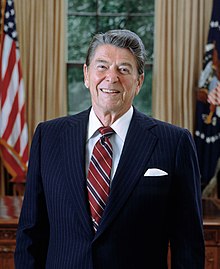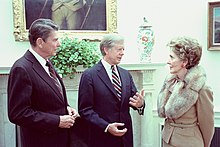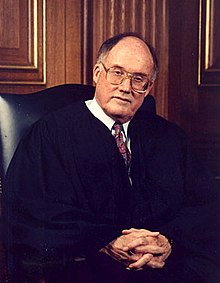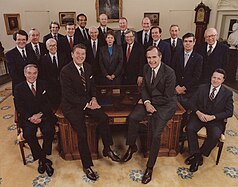
A | B | C | D | E | F | G | H | CH | I | J | K | L | M | N | O | P | Q | R | S | T | U | V | W | X | Y | Z | 0 | 1 | 2 | 3 | 4 | 5 | 6 | 7 | 8 | 9
 | |
| Presidency of Ronald Reagan January 20, 1981 – January 20, 1989 | |
| Cabinet | See list |
|---|---|
| Party | Republican |
| Election | |
| Seat | White House |
|
| |
| Library website | |
| ||
|---|---|---|
|
Personal life 33rd Governor of California
40th President of the United States Legacy |
||
Ronald Reagan's tenure as the 40th president of the United States began with his first inauguration on January 20, 1981, and ended on January 20, 1989. Reagan, a Republican from California, took office following his landslide victory over Democrat incumbent president Jimmy Carter and independent congressman John B. Anderson in the 1980 presidential election. Four years later, in the 1984 presidential election, he defeated former Democratic vice president Walter Mondale, to win re-election in a larger landslide. Due to U.S. Constitutional law, Reagan was limited to two terms and was succeeded by his vice president, George H. W. Bush, who won the 1988 presidential election. Reagan's 1980 landslide election resulted from a dramatic conservative shift to the right in American politics, including a loss of confidence in liberal, New Deal, and Great Society programs and priorities that had dominated the national agenda since the 1930s.
Domestically, the Reagan administration enacted a major tax cut, sought to cut non-military spending, and eliminated federal regulations. The administration's economic policies, known as "Reaganomics", were inspired by supply-side economics. The combination of tax cuts and an increase in defense spending led to budget deficits, and the federal debt increased significantly during Reagan's tenure. Reagan signed the Tax Reform Act of 1986, simplifying the tax code by reducing rates and removing several tax breaks, and the Immigration Reform and Control Act of 1986, which enacted sweeping changes to U.S. immigration law and granted amnesty to three million illegal immigrants. Reagan also appointed more federal judges than any other president, including four Supreme Court Justices.
Reagan's foreign policy stance was resolutely anti-communist; its plan of action, known as the Reagan Doctrine, sought to roll back the global influence of the Soviet Union in an attempt to end the Cold War. Under his doctrine, the Reagan administration initiated a massive buildup of the United States military; promoted new technologies such as missile defense systems; and, in 1983, undertook an invasion of Grenada, the first major overseas action by U.S. troops since the end of the Vietnam War. The administration also created controversy by granting aid to paramilitary forces seeking to overthrow leftist governments, particularly in war-torn Central America and Afghanistan. Specifically, the Reagan administration engaged in covert arms sales to Iran to fund Contra rebels in Nicaragua that were fighting to overthrow their nation's socialist government; the resulting Iran–Contra affair led to the conviction or resignation of several administration officials. During Reagan's second term, he sought closer relations with Soviet leader Mikhail Gorbachev, and the two leaders signed a major arms control agreement known as the INF Treaty.
Historians and political scientists generally rank Reagan in the upper tier of American presidents, and consider him to be one of the most important presidents since Franklin D. Roosevelt. Supporters of Reagan's presidency have pointed to his contributions to the economic recovery of the 1980s, the peaceful end of the Cold War, and a broader restoration of American confidence. Reagan's presidency has received criticism for rising budget deficits and wealth inequality during and after his presidency, as well as for his leadership of the executive branch, particularly during the Iran–Contra affair. Due to Reagan's impact on public discourse and advocacy of American conservatism, some historians have described the period during and after his presidency as the Reagan Era.
Background
Conservative shift in politics

Even prior to becoming president, Reagan was the leader of a dramatic conservative shift that undercut many of the domestic and foreign policies that had dominated the national agenda for decades.[1][2] A major factor in the rise of conservatism was the growing distrust of government in the aftermath of the Watergate scandal. While distrust of high officials had been an American characteristic for two centuries, Watergate engendered heightened levels of suspicion and encouraged the media to engage in a vigorous search for scandals.[3] An unexpected new factor was the emergence of the religious right as a cohesive political force that gave strong support to conservatism.[4][5]
Other factors in the rise of the conservative movement were the emergence of a "culture war" as a triangular battle among conservatives, traditional liberals, and the New Left, involving such issues as individual freedom, divorce, sexual freedom, abortion, and homosexuality.[6] A mass movement of population from the cities to the suburbs led to the creation of a new group of voters less attached to New Deal economic policies and machine politics.[7] Meanwhile, it became socially acceptable for conservative Southern whites, especially well-educated suburbanites, to vote Republican. Though the civil rights legislation of the 1960s had been a triumphal issue for liberalism and had created a new, pro-Democratic black electorate, it had also destroyed the argument that whites had to vote Democratic to protect segregation in the South.[8] Responding to these various trends, Reagan and other conservatives successfully presented conservative ideas as an alternative to a public that had grown disillusioned with New Deal liberalism and the Democratic Party.[9] Reagan's charisma and speaking skills helped him frame conservatism as an optimistic, forward-looking vision for the country.[10]
1980 election

Reagan, who had served as Governor of California from 1967 to 1975, narrowly lost the 1976 Republican presidential primaries to incumbent President Gerald Ford. With the defeat of Ford by Democrat Jimmy Carter in the 1976 election, Reagan immediately became the front-runner for the 1980 Republican presidential nomination.[11] A darling of the conservative movement, Reagan faced more moderate Republicans such as George H. W. Bush, Howard Baker, and Bob Dole in the 1980 Republican presidential primaries. After Bush won the Iowa caucuses, he became Reagan's primary challenger, but Reagan won the New Hampshire primary and most of the following primaries, gaining an insurmountable delegate lead by the end of March 1980. Ford was Reagan's first choice for his running mate, but Reagan backed away from the idea out of the fear of a "co-presidency" in which Ford would exercise an unusual degree of power. Reagan instead chose Bush, and the Reagan-Bush ticket was nominated at the 1980 Republican National Convention. Meanwhile, Carter won the Democratic nomination, defeating a primary challenge by Senator Ted Kennedy. Polls taken after the party conventions showed a tied race between Reagan and Carter, while independent candidate John B. Anderson had the support of many moderates.[12]

The 1980 general campaign between Reagan and Carter was conducted amid a multitude of domestic concerns and the ongoing Iran hostage crisis. After winning the Republican nomination, Reagan pivoted to the center. Though he continued to champion a major tax cut, Reagan backed off of his support for free trade and the privatization of Social Security, and promised to consider arms control treaties with the Soviet Union. He instead sought to focus the race on Carter's handling of the economy. Mired with an approval rating in the low 30s, Carter also waged a negative campaign, focusing on the supposed risk of war if Reagan took office.[13]
Reagan and Carter met in one presidential debate, held just one week before election day. Reagan delivered an effective performance, asking voters, "Are you better off today than you were four years ago?"[14] In response to a characterization by Carter of his record regarding Medicare, Reagan replied with a phrase that helped define the election and endure in the political lexicon: "There you go again."
Though the race had been widely regarded as a close contest, Reagan won over the large majority of undecided voters.[15] Reagan took 50.7% of the popular vote and 489 of the 538 electoral votes. Carter won 41% of the popular vote and 49 electoral votes, while Anderson won 6.6% of the popular vote. In the concurrent congressional elections, Republicans took control of the Senate for the first time since the 1950s, while Democrats retained control of the House of Representatives.[16]
Administration
Reagan tapped James Baker, who had run Bush's 1980 campaign, as his first chief of staff. Baker, Deputy Chief of Staff Michael Deaver, and Counselor Edwin Meese formed the "troika," the key White House staffers early in Reagan's presidency.[17] Baker quickly established himself as the most powerful member of the troika and the overseer of day-to-day operations, while Meese had nominal leadership of policy development and Deaver orchestrated Reagan's public appearances.[18] Aside from the troika, other important White House staffers included Richard Darman and David Gergen.[19][20][21]
Reagan chose Alexander Haig, a former general who had served as chief of staff to Richard Nixon, as his first secretary of state. Other major Cabinet appointees included Secretary of Defense Caspar Weinberger, a former Nixon cabinet official who would preside over an increase in defense spending, and Secretary of the Treasury Donald Regan, a bank executive. Reagan selected David Stockman, a young congressman from Michigan, as the Director of the Office of Management and Budget.[22] CIA director William J. Casey emerged as an important figure in the administration, as the CIA would figure prominently into Reagan's Cold War initiatives. Reagan downgraded the importance of the national security advisor, and six different individuals held that position during Reagan's presidency.[23]
Haig left the cabinet in 1982 after clashing with other members of the Reagan administration, and was replaced by another former Nixon administration official, George P. Shultz.[24] By 1982, National Security Advisor William P. Clark Jr., Ambassador to the United Nations Jeane Kirkpatrick, and CIA Director Casey had established themselves as the major figures in the formulation of the administration's foreign policy.[25] Shultz eventually emerged as the administration's most influential foreign policy figure, moving the administration towards a less confrontational policy with the Soviet Union.[26]
Baker and Treasury Secretary Regan switched positions at the beginning of Reagan's second term.[27] Regan centralized power within his office, and he took on the responsibilities that had been held by Baker, Deaver, and Meese, the latter of whom succeeded William French Smith as attorney general in 1985.[28] Regan frequently clashed with First Lady Nancy Reagan, and he left the administration in the wake of the Iran–Contra affair and Republican losses in the 1986 mid-term elections. Regan was replaced by former Senate Majority Leader Howard Baker.[29]
Judicial appointments
Supreme Court

Reagan made four successful appointments to the Supreme Court during his eight years in office. In 1981, he successfully nominated Sandra Day O'Connor to succeed Associate Justice Potter Stewart, fulfilling a campaign promise to name the first woman to the Supreme Court. Democrats, who had planned to vigorously oppose Reagan's nominations to the Supreme Court, approved of the nomination of O'Connor. However, the Christian right was astonished and dismayed with O'Connor, who they feared would not overturn the Supreme Court's decision in Roe v. Wade, which had established the constitutional right to have an abortion without undue government interference.[30][31] O'Connor served on the Supreme Court until 2006, and was generally considered to be a centrist conservative.[32]
In 1986, Reagan elevated Associate Justice William Rehnquist to the position of Chief Justice of the United States after Warren Burger chose to retire.[33] Rehnquist, a member of the conservative wing of the Court,[32] was the third sitting associate justice to be elevated to chief justice, after Edward Douglass White and Harlan F. Stone. Reagan successfully nominated Antonin Scalia to fill Rehnquist's position as an associate justice of the Supreme Court.[33] Scalia became a member of the Court's conservative wing.[32]
Reagan faced greater difficulties in filling the final Supreme Court vacancy, which arose due to the retirement of Lewis F. Powell Jr. Reagan nominated Robert Bork in July 1987, but the nomination was rejected by the Senate in October 1987.[33] Later that month, Reagan announced the nomination of Douglas H. Ginsburg, but Ginsburg withdrew from consideration in November 1987. Finally, Reagan nominated Anthony Kennedy, who won Senate confirmation in February 1988.[33] Along with O'Connor, Kennedy served as the key swing vote on the Supreme Court in the decades after Reagan left office.[34]
Other courts
Reagan appointed a combined total of 368 judges to the United States courts of appeals and the United States district courts, more than any other president. The vast majority of his judicial appointees were conservative white men, and many of the appointees were affiliated with the conservative Federalist Society.[35] Partly because Congress passed a law creating new federal judicial positions in 1984, Reagan had appointed nearly half of the federal judiciary by the time he left office in 1989.[36]
Assassination attempt
On March 30, 1981, only 69 days into the new administration, Reagan, his press secretary James Brady, Washington police officer Thomas Delahanty, and Secret Service agent Tim McCarthy were struck by gunfire from would-be assassin John Hinckley Jr. outside the Washington Hilton Hotel. Although Reagan was initially reported to be "close to death",[37] he recovered and was released from the hospital on April 11, becoming the first serving president to survive being wounded in an assassination attempt.[38] The failed assassination attempt had great influence on Reagan's popularity; polls indicated his approval rating to be around 73%.[39][40] Many pundits and journalists later described the failed assassination as a critical moment in Reagan's presidency, as his newfound popularity provided critical momentum in passing his domestic agenda.[41]
Domestic affairs
Reagan used his White House staff to shape major domestic policies. His Chief of Staff made heavy use of the Office of Policy Development in supervising cabinet action on the Reagan initiatives.[42]
"Reaganomics" and taxation

Economic Recovery Tax Act of 1981
Reagan implemented neoliberal economic policies based on supply-side economics, advocating a laissez-faire philosophy and free-market fiscal policy.[43][44] Reagan's taxation policies resembled those instituted by President Calvin Coolidge and Treasury Secretary Andrew Mellon in the 1920s. Reagan's team was also strongly influenced by contemporary economists such as Arthur Laffer, who rejected the then-dominant views of Keynesian economists.[45] Reagan relied on Laffer and other economists to argue that tax cuts would reduce inflation, which went against the prevailing Keynesian view.[46] Supply-side advocates also asserted that cutting taxes would ultimately lead to higher government revenue due to economic growth, a proposition that was challenged by many economists.[47]
Republican Congressman Jack Kemp and Republican Senator William Roth had nearly won passage of a major tax cut during Carter's presidency, but Carter had prevented passage of the bill due to concerns about the deficit.[48] Reagan made passage of the Kemp–Roth bill his top domestic priority upon taking office. As Democrats controlled the House of Representatives, passage of any bill would require the support of some House Democrats in addition to the support of congressional Republicans.[49] Reagan's victory in the 1980 presidential campaign had united Republicans around his leadership, while conservative Democrats like Phil Gramm of Texas (who later became a Republican) were eager to back some of Reagan's conservative policies.[50] Throughout 1981, Reagan frequently met with members of Congress, focusing especially on winning support from conservative Southern Democrats.[49] Reagan also benefited from a conservative majority in the House during his first two years as president, with an estimated 230 votes during the 97th Congress, although this changed after the Democratic gains in the 1982 election, with House control switching to liberals within the Democratic caucus.[51]
In July 1981, the Senate voted 89–11 in favor of the tax cut bill favored by Reagan, and the House subsequently approved the bill in a 238–195 vote.[52] The Economic Recovery Tax Act of 1981 cut the top marginal tax rate from 70% to 50%, lowered the capital gains tax from 28% to 20%, more than tripled the amount of inherited money exempt from the estate tax, and cut the corporate tax.[49][52] Reagan's success in passing a major tax bill and cutting the federal budget was hailed as the "Reagan Revolution" by some reporters; one columnist wrote that the Reagan's legislative success represented the "most formidable domestic initiative any president has driven through since the Hundred Days of Franklin Roosevelt."[53]
Later tax acts
Faced with concerns about the mounting federal debt, Reagan agreed to raise taxes, signing the Tax Equity and Fiscal Responsibility Act of 1982 (TEFRA).[54] Many of Reagan's conservative supporters condemned TEFRA, but Reagan argued that his administration would be unable to win further budget cuts without the tax hike.[55] Among other provisions, TEFRA doubled the federal cigarette tax and rescinded a portion of the corporate tax cuts from the 1981 tax bill.[56] By 1983, the amount of federal tax had fallen for all or almost all American taxpayers, but most strongly affected the wealthy; the proportion of income paid in taxes by the richest one percent fell from 29.8 percent to 24.8 percent.[57] Partly due to the poor economy, Reagan's legislative momentum dissipated after his first year in office, and his party lost several seats in the House in the 1982 congressional elections.[58] Compared to other midterm elections, the losses were relatively small for the party holding the presidency, but conservative Democrats were less open to Reagan's initiatives after 1982.[59] As deficits continued to be an issue, Reagan signed another bill that raised taxes, the Deficit Reduction Act of 1984.[60]
With Donald Regan taking over as Chief of Staff in 1985, the Reagan administration made simplification of the tax code the central focus of its second term domestic agenda.[61] Working with Speaker of the House Tip O'Neill, a Democrat who also favored tax reform, Reagan overcame significant opposition from members of Congress in both parties to pass the Tax Reform Act of 1986.[62] The act simplified the tax code by reducing the number of tax brackets to four and slashing a number of tax breaks. The top rate was dropped to 28%, but capital gains taxes were increased on those with the highest incomes from 20% to 28%. The increase of the lowest tax bracket from 11% to 15% was more than offset by expansion of the personal exemption, standard deduction, and earned income tax credit. The net result was the removal of six million poor Americans from the income tax roll and a reduction of income tax liability at all income levels.[63][64] The net effect of Reagan's tax bills was that overall tax burden held steady at roughly 19 percent of gross national product.[65]





